Sun Safety for Kids: 4 Tips for a Safe & Fun Summer
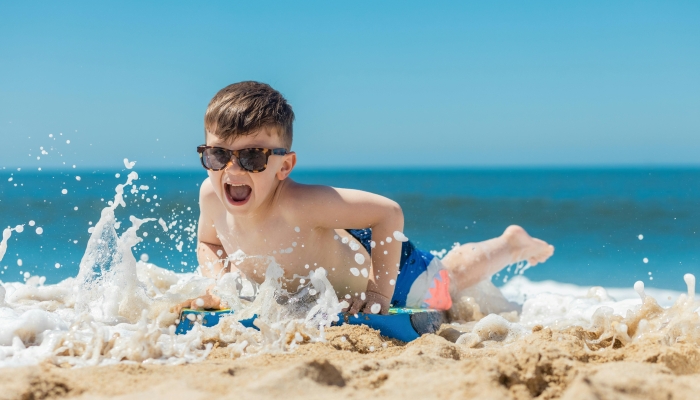
- Be mindful of the effects of UV radiation and practice sun safety skills while outdoors during peak hours.
- Use a broad-spectrum sunscreen to provide sun protection from ultraviolet (UV) rays.
- Consider different types of protective clothing and accessories to protect a child’s delicate skin from sunburn.
- Know when to seek medical care for excessive sun exposure.
Ah, summer. The magic of those long, lazy days is a welcome break from the pressures of the school year.
Filled with lemonade and popsicles, lulled by the gentle hum of lawnmowers and nature sounds, and punctuated by frequent breaks for snacks and reapplying sunscreen, there’s nothing like spending time outdoors watching your child play and soaking up the long-anticipated days of warmth and sunshine.
However, your summertime bliss may be negatively impacted if you skip the sunscreen or forget to wear sunglasses. Taking the time to provide extra protection for your child’s vulnerable skin is worth it to avoid sunburns and other health conditions.
Learn more about ways to practice sun safety for kids so all family members can safely enjoy their time outdoors this summer.
1. Understand the Sun’s Peak Hours
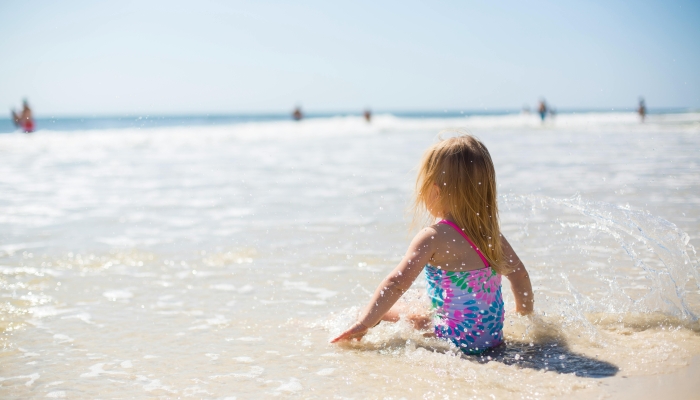
As the name suggests, peak sun hours refer to a relatively brief period (i.e. a few hours) where the sun’s rays shine with direct, intense light. Most sun damage occurs at this time because UV rays are also more intense.
For most people in the Northern Hemisphere, peak sun hours occur between 10 AM and 4 PM (approximately) each day.
UVA rays and UVB rays can cause the effects of sun exposure11. Schoonmaker, D.. Sunshine on a Cloudy Day. American Scientist. https://www.americanscientist.org/article/sunshine-on-a-cloudy-day (including sunburn and increased risk of skin cancer), even on cloudy days. That’s because clouds may block sunlight, but UV rays and radiation still pass through.
To protect your little one’s delicate skin from sun damage, consider limiting outdoor activities during these hours, seek out shade or a sheltered spot, or plan to use sunscreen to prevent skin damage.
2. Choose the Right Sunscreen
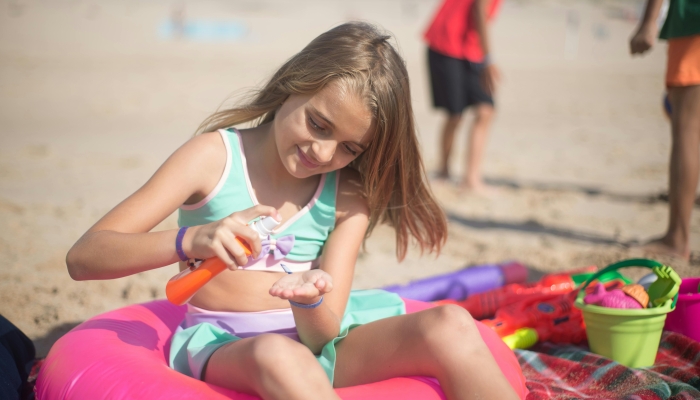
There are different schools of thought regarding sunscreen use among parents. Some feel that sunscreen is a barrier—literally and figuratively—to raising vitamin D levels and other benefits of sun exposure22. Raymond-Lezman, J. R., & Riskin, S. I.. Benefits and Risks of Sun Exposure to Maintain Adequate Vitamin D Levels. Cureus. 2023. https://doi.org/10.7759/cureus.38578. Others reach for the zinc oxide as soon as they know they’ll spend time outdoors that day.
What’s the right answer?
According to experts from the American Academy of Dermatology (AAD)33. Infant Sun Protection: How parents can keep their baby safe. American Academy of Dermatology. https://www.aad.org/public/diseases/skin-cancer/prevent/sun-babies, both sides have a point.
Like the AAD, experts from the Food and Drug Administration (FDA)44. FDA. Should You Put Sunscreen on Infants? Not Usually. U.S. Food and Drug Administration. 2024. https://www.fda.gov/consumers/consumer-updates/should-you-put-sunscreen-infants-not-usually and the American Academy of Pediatrics (AAP)55. Sun Safety: Information for Parents About Sunburn & Sunscreen. HealthyChildren.org. 2023. https://www.healthychildren.org/English/safety-prevention/at-play/Pages/Sun-Safety.aspx recommend avoiding sunscreen for kids under six months of age. These children can indeed spend time outdoors but should avoid direct sunlight and primarily stay in the shade to prevent long-term sun and skin damage to vulnerable skin.
Older kids should use sunscreen when spending more than a few minutes outside.
Tips for Choosing Child-Friendly Sunscreen
When selecting sunscreen for your child, look for products that include the following features:
- Broad-spectrum sunscreen formulas. As the name suggests, these products offer both UVA and UVB protection. These factors are helpful to decrease your child’s long-term risk of developing skin cancer.
- SPF (sun protection factor or ultraviolet protection factor) 30 or greater. The higher the SPF, the more protection from the harmful effects of the sun’s rays.
- Lotion-like preparations or sprays. Cream or liquid sunscreens tend to be preferred by parents of young children—it’s easy to know how much you’re putting on your child and simple to tell which areas have been covered. However, spray sunscreens are much easier to use and are more likely to be reapplied throughout the day, as confirmed in a 2019 research study66. Oh, M., Kim, S., Han, J. et al.. Study on Consumer Exposure to Sun Spray and Sun Cream in South Korea. Toxicol Res. 2019;35, 389–394. https://doi.org/10.5487/TR.2019.35.4.389. Avoid spraying sunscreen directly on your child’s face if using an aerosolized formula; instead, spray it into your hands and then apply it to the face to avoid directly inhaling potentially dangerous propellants.
- Water-resistant. While no sunscreen is truly water-proof, preparations that are water resistant can prevent sunburn and sun damage while children are in the water. Parents or young people should reapply sunscreen after swimming or sweating to provide continued UV protection.
Apply sunscreen early and often to provide the best protection against UVA and UVB rays, which will protect your child from sunburn and developing skin cancer in later life from UV radiation exposure.
3. Dress for Sun Protection
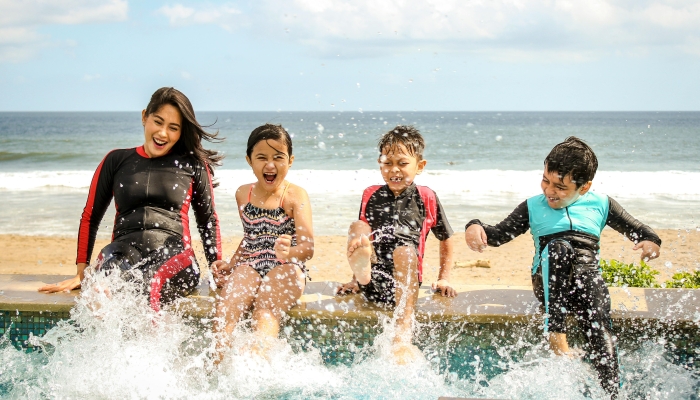
In North America, many people associate a tan as a sign of health. However, a tan or sunburn means that your skin has had too much exposure to UV rays, resulting in visible damage.
It may help to think of healthy skin as skin that is appropriately protected against UV exposure instead of the presence (or absence) of a specific color.
What does it look like to dress for success in terms of sun protection?
Protective Clothing
As parents, we can set a good example for our children by being mindful of what we wear when preparing to spend time outdoors.
A good rule of thumb is to dress your child as you would dress yourself, which means wearing appropriate, protective clothing.
Consider providing extra UV protection in the form of clothing and accessories by:
- Dressing your child in long-sleeved clothing that covers most of their exposed areas. This provides a tangible barrier to protect a young child’s skin.
- Offering lightweight clothing made from breathable fabrics. Think cotton clothing or linen that offers physical protection from the sun and allows body heat to escape from the fabric instead of synthetic fabrics with a tight weave that may hold heat in.
- Covering sensitive areas like the neck or ears by using a wide-brimmed hat.
- Donning “extras,” like a baseball cap (or other types of brimmed hats), sunglasses, or sandals. A stroller with a sunshade or hood can offer your child extra protection from the sun.
Correctly dressing your child to enjoy play in the sun matters as much as the sunscreen you apply to your child’s skin.
4. Managing Sun Overexposure
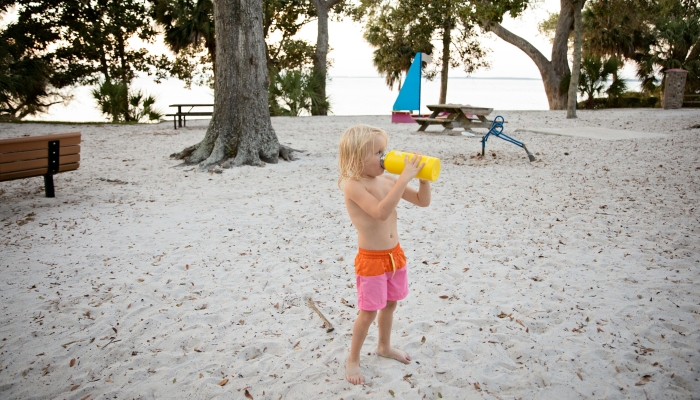
Too much time in the sun—even with proper precautions and frequent use of zinc oxide or titanium dioxide-based sunscreens—can be dangerous for kids.
Children are more likely than adults to become dehydrated77. Heat Stroke and Dehydration in Kids. Pediatric Associates of Franklin. https://www.pediatricsoffranklin.com/resources-and-education/heat-stroke-and-dehydration-in-kids through time in the sun for two reasons:
First, they have more body surface area as compared to their overall weight, meaning they can rapidly burn through their body water reserves and experience clinical signs of dehydration.
Secondly, your child is likely more focused on playing and enjoying time outside than drinking water or other fluids. Your child may not be aware of their thirst until they’re already compromised.
Symptoms of Sun Overexposure
Children’s Hospital Colorado reports that it’s time to stop fun in the sun and move your child to the shade if you notice these signs of heat reactions88. Heat Exposure and Reactions. Children’s Hospital Colorado. https://www.childrenscolorado.org/conditions-and-advice/conditions-and-symptoms/symptoms/heat-exposure-and-reactions :
- Heat stroke or sunstroke: Symptoms include hot, flushed skin with a fever higher than 105℉. If your child is experiencing heat stroke, they may sweat less than you’d expect given their symptoms, or not sweat at all. These are serious, potentially fatal conditions that require emergency medical care from a qualified healthcare provider.
- Heat exhaustion: Signs include pale skin, excessive sweating, nausea, dizziness, fainting, or weakness. A fever (100℉–102℉) may also be briefly present. Heat exhaustion can progress to heat stroke, so contact your child’s doctor or seek emergency medical care if you suspect this condition.
- Heat cramps: These severe muscle cramps are caused by dehydration and are seen as severe stomach or leg (calf or thigh muscle) cramps, along with tightness or spasms in the hands. Fevers are not a typical symptom. Cramps usually improve in a few hours as your child rests, drinks fluids, and spends time in the shade or cool environment.
The best defense is a good offense. Encourage your children to drink extra fluids ahead of time when preparing to spend extended periods outdoors and regularly offer water to help replenish what’s lost through sweat and activity.
Practicing sun safety skills doesn’t mean you need to stay indoors all summer. By making thoughtful preparations to protect your child by selecting the right sunscreen, dressing them in appropriate clothing, and seeking shade when necessary, you can safely enjoy your time in the sun and make this summer one to remember.
References
- Schoonmaker, D. (n.d.). Sunshine on a Cloudy Day. American Scientist. https://www.americanscientist.org/article/sunshine-on-a-cloudy-day
- Raymond-Lezman, J. R., & Riskin, S. I. (2023). Benefits and Risks of Sun Exposure to Maintain Adequate Vitamin D Levels. Cureus. https://doi.org/10.7759/cureus.38578
- Infant Sun Protection: How parents can keep their baby safe. American Academy of Dermatology. (n.d.). https://www.aad.org/public/diseases/skin-cancer/prevent/sun-babies
- FDA. (2024, May 9). Should You Put Sunscreen on Infants? Not Usually. U.S. Food and Drug Administration. https://www.fda.gov/consumers/consumer-updates/should-you-put-sunscreen-infants-not-usually
- Sun Safety: Information for Parents About Sunburn & Sunscreen. HealthyChildren.org. (2023, November 20). https://www.healthychildren.org/English/safety-prevention/at-play/Pages/Sun-Safety.aspx
- Oh, M., Kim, S., Han, J. et al. Study on Consumer Exposure to Sun Spray and Sun Cream in South Korea. Toxicol Res. 35, 389–394 (2019). https://doi.org/10.5487/TR.2019.35.4.389
- Heat Stroke and Dehydration in Kids. Pediatric Associates of Franklin. (n.d.). https://www.pediatricsoffranklin.com/resources-and-education/heat-stroke-and-dehydration-in-kids
- Heat Exposure and Reactions. Children’s Hospital Colorado. (n.d.). https://www.childrenscolorado.org/conditions-and-advice/conditions-and-symptoms/symptoms/heat-exposure-and-reactions
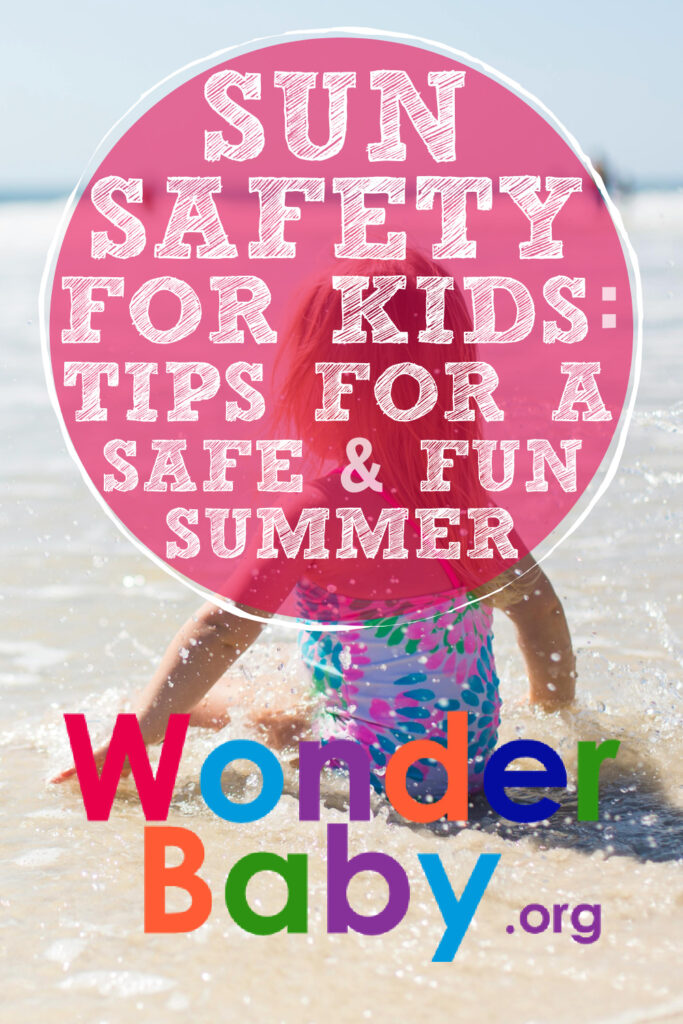
The information WonderBaby provides is not intended to be, and does not constitute, medical or other health advice or diagnosis and should not be used as such. Always consult with a qualified medical professional about your specific circumstances.
Related Posts

Health & Nutrition
Can Baby Skin Care Products Expire?
Is that forgotten tube of diaper rash cream still safe to use? Learn more about the expiration dates of popular skin care products for infants.

Health & Nutrition
Boosting Immunity in Kids: 3 Tips for a Healthy Winter
Parents can help boost their kids’ immunity during cold and flu season by maintaining healthy eating, sleeping, and exercising habits in the winter.

Health & Nutrition
Flat Head Syndrome and Torticollis: What You Should Know
Torticollis, or tight muscles in the neck, may cause your baby to have a flat spot on their head that needs to be assessed and treated by a physician.